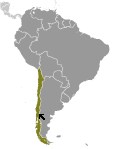World Atlas: Chile. On this page you can see the map, country flag and many detailed information about the people, history and economy of Chile.

Here you can find online selected information about the geography, inhabitants, government, economy and history of Chile. Included are selected statistics, an overview map and the detailed map of Chile. But let's start with the flag of Chile here:
Chile - Overview:
What you should know about Chile? Let's start with this: Prior to the arrival of the Spanish in the 16th century, the Inca ruled northern Chile while an indigenous people, the Mapuche, inhabited central and southern Chile. Although Chile declared its independence in 1810, it did not achieve decisive victory over the Spanish until 1818. In the War of the Pacific (1879-83), Chile defeated Peru and Bolivia to win its present northern regions. In the 1880s, the Chilean central government gained control over the central and southern regions inhabited by the Mapuche. After a series of elected governments, the three-year-old Marxist government of Salvador Allende was overthrown in 1973 by a military coup led by General Augusto Pinochet, who ruled until a democratically-elected president was inaugurated in 1990. Sound economic policies, maintained consistently since the 1980s, contributed to steady growth, reduced poverty rates by over half, and helped secure the country's commitment to democratic and representative government. Chile has increasingly assumed regional and international leadership roles befitting its status as a stable, democratic nation.
Geography of Chile
 Where on the globe is Chile? The location of this country is Southern South America, bordering the South Pacific Ocean, between Argentina and Peru. Total area of Chile is 756,102 sq km, of which 743,812 sq km is land. So this is quite a large country. How could we describe the terrain of the country? This way: low coastal mountains, fertile central valley, rugged Andes in east. The lowest point of Chile is Pacific Ocean 0 m, the highest point Nevado Ojos del Salado 6,880 m. And the climate is temperate; desert in north; Mediterranean in central region; cool and damp in south.
Where on the globe is Chile? The location of this country is Southern South America, bordering the South Pacific Ocean, between Argentina and Peru. Total area of Chile is 756,102 sq km, of which 743,812 sq km is land. So this is quite a large country. How could we describe the terrain of the country? This way: low coastal mountains, fertile central valley, rugged Andes in east. The lowest point of Chile is Pacific Ocean 0 m, the highest point Nevado Ojos del Salado 6,880 m. And the climate is temperate; desert in north; Mediterranean in central region; cool and damp in south.
Inhabitants of Chile
Let's take a look how many people live in Chile. The number is: 17,789,267 (July 2017 est.). So this is not very populous country. Who lives here? white and non-indigenous 88.9%, Mapuche 9.1%, Aymara 0.7%, other indigenous groups 1% (includes Rapa Nui, Likan Antai, Quechua, Colla, Diaguita, Kawesqar, Yagan or Yamana), unspecified 0.3% (2012 est.). What are the languages in Chile? Spanish 99.5% (official), English 10.2%, indigenous 1% (includes Mapudungun, Aymara, Quechua, Rapa Nui), other 2.3%, unspecified 0.2%. And the religions: Roman Catholic 66.7%, Evangelical or Protestant 16.4%, Jehovah's Witness 1%, other 3.4%, none 11.5%, unspecified 1.1% (2012 est.). How old are the people in average? 34.4 years. We have to add that this number is the median - so one half of the people is older than this, one half is younger. And what is their life expectancy (at birth)? This: 78.9 years. Where the people live in Chile? Here: 90% of the population is located in the middle third of the country around the capital of Santiago; the far north (anchored by the Atacama Desert) and the extreme south are relatively underpopulated. The major urban areas of Chile are: Santiago (capital) 6.507 million; Valparaiso 907,000; Concepcion 816,000 (2015).
Government and Economy of Chile
The capital of Chile is Santiago; note - Valparaiso is the seat of the national legislature and the government type presidential republic. Let's take a look at the administrative divisions - 15 regions (regiones, singular - region); Aysen, Antofagasta, Araucania, Arica y Parinacota, Atacama, Biobio, Coquimbo, Libertador General Bernardo O'Higgins, Los Lagos, Los Rios, Magallanes y de la Antartica Chilena, Maule, Region Metropolitana (Santiago), Tarapaca, Valparaiso. Regarding the economy of Chile, important industrial products are copper, lithium, other minerals, foodstuffs, fish processing, iron and steel, wood and wood products, transport equipment, cement, textiles. Important agricultural products are grapes, apples, pears, onions, wheat, corn, oats, peaches, garlic, asparagus, beans; beef, poultry, wool; fish; timbe. The most important export commodities are copper, fruit, fish products, paper and pulp, chemicals, wine and the most important export partners are China 28.6%, US 14.1%, Japan 8.6%, South Korea 6.9%, Brazil 5% (2016). The most important import commodities are petroleum and petroleum products, chemicals, electrical and telecommunications equipment, industrial machinery, vehicles, natural gas and the most important import partners are China 24.3%, US 14.7%, Brazil 9.3%, Argentina 4.4%, France 4.2% (2016). How rich is Chile and how rich are people in this country? The most important number here is GDP per capita (PPP): $24,600 (2017 est.). This means the living standards are good here. Let's add that this means Gross Domestic Product per person, which is recalculated with respect to the relative cost of local goods and services. And one more important number - population below poverty line: 14.4% (2013).